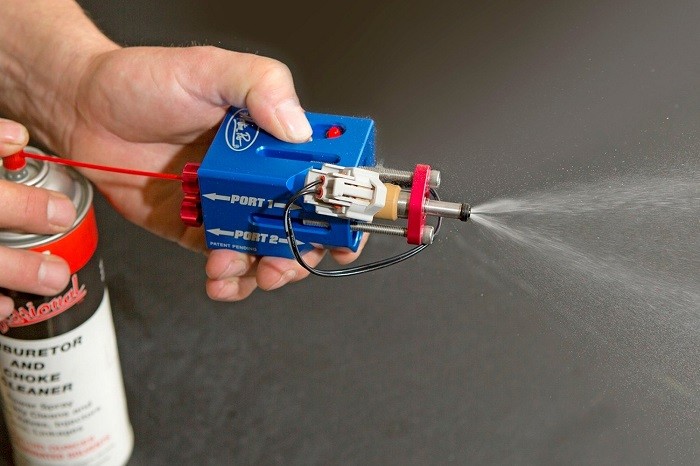
Как промыть топливную форсунку
Содержание
Clean fuel injectors help keep your engine running smoothly and efficiently. Clogged fuel injectors result in reduced fuel economy and loss of power.
The easiest way to distribute a liquid or vapor through any propulsion system is to ensure that the system is clean and free of obstructions. This applies especially to today’s modern fuel systems, which distribute fuel and air mixtures into the cylinder head intake manifold by way of the fuel injector. When the fuel injectors are clean and free of blockages, the engine runs smoothly and efficiently. When they are dirty, it can significantly impact the operation of the entire engine. There are a few warning signs of clogged fuel injectors, including a reduction in fuel economy or engine power, or black smoke coming from the exhaust.
Method 1 of 2: Using fuel injector cleaning additives
Необходимый материал
- Fuel injector cleaning additive
Step 1: Purchase the fuel injector cleaning additive. Most of the time, DIY mechanics will start with this method to clean their fuel injectors if they begin to notice any of the common warning signs. The first step is to buy a small bottle of formula, enough for three to four gas tank fill ups.
If you choose to use it, the recommended dosage of Lucas Oil’s Fuel Treatment is 2 to 3 ounces per 10 gallons of fuel.
Step 2: Pour the fuel treatment into the gas tank. Make sure to do this after filling the fuel tank. Add the recommended dosage after you determine how much fuel you added.
Keep it inside your vehicle to make sure you can add it with every fill up and on a consistent basis for best results.
Step 3: Continue this process for a minimum of three to four full tanks. The drawback of using fuel additives is that they are added in very small amounts so as to not negatively impact the performance of the vehicle or to trigger alerts caused by most fuel-related sensors.
It will take some time for them to work, but if done correctly, they should do a good job cleaning up the fuel injectors as well as the entire fuel system.
Method 2 of 2: Using fuel injector kits
Необходимые материалы
- Fuel injector cleaner kit
- Fuel injector cleaning solution
- Hand tools for removing fuel lines, disconnecting the fuel pump or power to the fuel pump
- Safety equipment including gloves and safety glasses
- Инструмент сканирования
Step 1: Hang the fuel injector cleaning tool from the hood. The system is air pressure applied but needs to be hung straight in order to work correctly.
Step 2: Pour the fuel injector cleaner into the cleaner tool. The fuel injector cleaning liquid is comprised of special additives as well as gasoline.
When you attach this device to the fuel system, the engine will run on the liquid inside the device. Once the liquid runs out, the engine will shut down.
You need to always refer to the exact instructions that the product manufacturer supplies in order for this process to work correctly.
Step 3: Disconnect the fuel lines on the fuel rail. Most fuel injector cleaning tools have an attachment that connects the fuel line from the fuel pump to the unit, and an attachment from the unit back to the fuel rail.
If your system does not have this attachment, you’ll have to disconnect the fuel line and disconnect power to the fuel pump so the unit does not supply fuel as the fuel injector cleaner is in use.
If your fuel injector cleaner has a connection to attach the fuel line to the unit, remove the fuel line from the rail and attach it to the unit. Then attach the fuel line from the unit back to the fuel rail.
If your fuel injector cleaner does not have this connection, you’ll have to remove power to the fuel pump, remove the fuel line connection to the rail and then install the fuel line from the unit to the fuel rail.
Step 4: Run the cleaner through the fuel injectors. Connect the fuel line from the cleaning tool to the fuel rail. Start the engine with the fuel line open from the cleaner to the fuel rail.
Let the engine run until the tank on the fuel injector cleaner tool is empty. Disconnect the fuel line from the tool and reconnect the primary fuel supply line from the fuel pump to the fuel rail. Reattach power to the fuel pump (if you had to remove it earlier).
Step 5: Start the engine, check for error codes or clear existing codes. One of the drawbacks of using this system is that it tends to trigger sensors that monitor the fuel injection system.
If you complete this process, you’ll need to have access to a digital scanner in order to clear these error codes.
If you’ve completed all of these steps and still can’t find out the source of the problem, or need an extra set of professional hands to help fix it, contact AvtoTachki to find a local ASE certified mechanic that will be happy to assist you. A diagnostic check will determine if you need to have the fuel injectors replaced.

